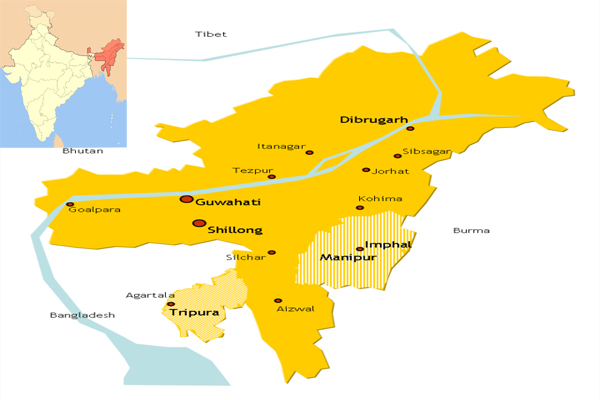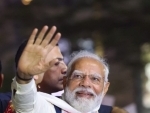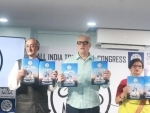
Northeast: The Troubles Endure
There was a sharp spike in civilian fatalities in the Northeast Region in 2014, after four consecutive years of registering less than 100 fatalities annually. The IK Songbijit faction of the National Democratic Front of Bodoland (NDFB-IKS) (Assam) which accounted for 184 fatalities [137 civilians, one Security Force (SF) and 43 of its own cadres] was the prime driver of the skewed trend. NDFB-IKS, led by Myanmar based Ingti Kathar Songbijit, is fighting for a 'sovereign Bodoland' for the Bodo tribesman of Assam.
There was also a surge in Meghalaya where splits in existing Garo militant groups fed a cycle of rising violence. Fratricidal killings among Naga militant groups, both within and outside Nagaland, however, declined. The trend for the other States in the region remained stable.
According to partial data compiled by the South Asia Terrorism Portal (SATP), 2014 registered a 84.52 per cent increase in overall fatality in the Northeast, as compared to 2013, primarily due to increased fatalities in Assam, where a 202 per cent rise in total fatalities (305) was recorded, in comparison to 2013 (101 fatalities). Assam accounted for 65.59 per cent of overall fatalities (465) across the Northeast in 2014; followed by Meghalaya (76 fatalities); Manipur (54); Nagaland (15); Arunachal Pradesh (nine); Tripura (four); and Mizoram (two). In 2013, Assam had registered 101 fatalities, followed by Meghalaya (60); Manipur (55); Nagaland (32); Arunachal Pradesh (four). No fatalities were recorded in Tripura and Mizoram in 2013.
In Assam the trend in overall fatalities has remained erratic over recent years. According to SATP, a sustained decline was recorded between 2010 and 2012, with a marginal increase in 2013, and then a dramatic surge in 2014, when 305 fatalities were recorded, including 184 civilians, five Security Force (SF) personnel and 116 militants. This was the highest number of civilian fatalities in the State since 2008, when civilian fatalities stood at 224. In the worst incident of civilian killings, at least 69 Adivasis[central Indian tribesman settled in Assam] were killed by NDFB-IKS militants in Sonitpur, Kokrajhar and Chirang Districts on December 23, 2014. NDFB-IKS's strategy of similar "soft target" killings also included the slaughter of 46 Muslim settlers in Baksa and Kokrajhar Districts in May 2014.
Meanwhile, in mid-February 2015, the Indian Army claimed that the entire top leadership of Karbi People's Liberation Tigers (KPLT) had been arrested. An Army release stated, "The operation has decimated the organisation and almost completely wiped out the dreaded KPLT from West Karbi Anglong District of Assam facilitating return of peace in the poorly developed region." Earlier, SFs had arrested 'chairman', 'commander-in-chief', 'deputy chief', 'finance secretary', 'auditor' and 'area commanders' of KPLT in different operations. However, Superintendent Of Police (SP- Karbi Anglong), Mugdha Jyoti Mahanta, on February 1, 2015, observed, "But the KPLT now has been split into five groups - KPLT (Buche group), KPLT (Pratap), KPLT (Donri), KPLT (Symbon) and KPLT (Sojong). Some of these groups have six-seven members."
Another six militant groups - Independent faction of United Liberation Front of Asom (ULFA-I), Kamatapur Liberation organisation (KLO), Harkat-ul Mujahideen (HuM-Assam unit), Muslim United Liberation Tigers of Assam (MULTA), Communist Party of India (CPI-Maoist) and Jama'atul Mujahideen Bangladesh (JMB) - presently remain active in Assam.
13 other militant groups are currently under Suspension of Operation (SoO) agreements with the Government. The Assam Government has spent over INR 9 million on the maintenance of 3,930 cadres of these groups in 24 designated camps. However, no new SoO agreement was signed in 2014.
14 fatalities [three civilian, one SF personal and 10 militants] have already been recorded in 2015 till March 22.
Meghalaya is the second-worst insurgency affected State in the Northeast, with a total of 76 fatalities in 2014 according to SATP data, as compared to 60 in 2013, an increase of 26.67 per cent. In spite of the rise in fatalities, however, indices suggest a consolidation of peace in the State. Significantly, civilian fatalities, which had been rising continuously since 2009, registered a decline of 17.86 per cent in 2014, as compared to the previous year, dropping from 28 to 23. Incidents of civilian killing in both years remained at 20. Civilian killings in 2014 were reported from five Garo Hills Districts, which accounted for all the insurgency-linked fatalities in the year, leaving the remaining six Districts of the State outside the ambit of lethal violence. In 2013, fatalities were reported from the West Khasi Hills and South West Khasi Hills Districts, as well, outside the Garo Hills Districts.
Fatalities among SF personnel, which had increased sharply in 2013, over 2012, recorded a decline in 2014. Two SF personnel were killed in 2012; nine in 2013, as against six in 2014. On the other hand, the State recorded the highest single-year fatalities among militants since 1992, with 47 killed in 2014. SF action led to 27 militant fatalities [in 22 encounters], while another 13 rebel cadres were killed in internecine clashes; seven militants were lynched by angry villagers in 2014. In 2013, militant fatalities stood at 23 - including 15 killed by SFs; six lynched by villagers; one killed in a factional clash; and another one killed by his own group, according to SATP data.
Garo militant groups, A'chik National Volunteer Council (ANVC) and Breakaway faction of ANVC (ANVC-B), were disbanded at a function at the Dikki-Bandi Stadium at Dakopgre in Tura town of West Garo Hills District on December 15, 2014. 748 cadres from both factions - 447 [ANVC] and 301 [of ANVC-B] were present as the 'chairmen' of the two militant formations - Dilash Marak [ANVC] and Bernard N. Marak [ANVC-B] - signed the Affirmation Agreement at the disbanding ceremony.
Significantly, a Counter Insurgency (CI) operation, Hill Storm was launched on July 11, 2014, to neutralize the Garo National Liberation Army (GNLA) and the Assam based ULFA-I. The Operation partially disrupted connectivity between Sohan D. Shira, 'commander-in-chief' of GNLA, and his immediate aides.
Multiple splits in militant outfits operating in the Garo Hills have led to an increase in abduction and extortion cases. Chief Minister Mukul Sangma, thus observed, "...the new outfits are mostly groups of deserters from ANVC, GNLA and others, who are mostly engaged in extortion and kidnappings and have no specific demands or ideology".
The general security environment in Manipur has seen marked improvement over the past six years. According to the SATP database, 54 fatalities [20 civilians, 10 SF personnel and 24 militants] were recorded in the State in 2014, as compared to 55 [21 civilians, six SF troopers, 28 militants] in 2013. Manipur had registered 485 insurgency-linked fatalities, including 131 civilians, 13 SF personnel and 341 militants, in 2008. Fatalities have registered a constant decline thereafter, with the exception of 2012, when there was a transient spike, primarily due to increasing militant fatalities. Fatalities among civilians have registered a continuous decline since 2008.
Fratricidal clashes among Naga militant formations in Manipur have also declined. There were just five such clashes in 2014 resulting in three fatalities, as against six such incidents, resulting in eight fatalities in 2013. These clashes occurred between the Zeliangrong United Front (ZUF) - at times a combined force of ZUF and Nationalist Socialist Council of Nagaland-Khaplang (NSCN-K) - and the NSCN-Isak-Muivah (NSCN-IM), and between NSCN-IM and NSCN-Khole-Kitovi (NSCN-KK).
The spillover of the Naga insurgency has led to considerable loss of life in Manipur. Deputy Chief Minister Gaikhangam Gangmei, who also holds the Home portfolio, revealed on July 15, 2014, that over 100 persons had been killed in Manipur by NSCN-IM since the 1980's. In 2014, at least 16 fatalities out of a total of 54 insurgency-linked deaths in the State, were linked to Naga groups.
At least 28 militant outfits remained active in Manipur through 2014, according to the SATP database, prominently including the People's Liberation Army (PLA), United National Liberation Front (UNLF), Kanglei Yawol Kanna Lup (KYKL), NSCN-IM and ZUF. On August 29, 2013, the Union Government had declared that 34 militant formations were active in Manipur.
17 fatalities [five civilian, one SF trooper and 12 militants] have already been recorded in 2015.
The relative peace achieved in Nagaland was further consolidated through 2014, as insurgency-related fatalities continued to decline. According to partial data compiled by SATP, the State recorded a total of 15 fatalities, including 11 civilians (three incidents) and four militants in 2014, as compared to 32 fatalities in 2013, including 11 civilians and 21 militants, a decline of 53.12 per cent. As in 2013, there was no fatality among SF personnel in 2014. Fatalities were reported from five Districts in 2014 against seven in 2013. The deepening peace is principally due to the signing of the 'Lenten Agreement' on March 28, 2014, during a two-day reconciliation meeting of three Naga militant groups - NSCN-IM, NSCN-KK and Naga National Council/ Federal Government of Nagaland (NNC/FGN) - at Dimapur, under the banner of the Forum for Naga Reconciliation (FNR). The agreement, signed by six top leaders of the three groups, stated that, in accordance with the Naga Concordant signed on August 26, 2011, they agreed "in principle to form the NNG [Naga National Government]". The joint statement, following the agreement, observed, "While this task is being carried out, we call for maintenance of the status quo, by vigilantly refraining from any unwarranted activities by the Nagas".
According to SATP data Arunachal Pradesh recorded a total of nine fatalities, including three civilians and six militants, through 2014, as against four fatalities (all militants) in 2013. Civilian killing was recorded in the State in 2014, for the first time since October 25, 2007. Out of the three civilian killings, at least two occurred during an Assam Rifles- NSCN-IM encounter in Tirap District.
Tripura recorded four fatalities in 2014, including two civilians and two SF personnel. Both SF personnel were killed by cadres of the Biswamohan faction of National Liberation Front of Tripura (NLFT-BM) near the unfenced portion of the India-Bangladesh border in Dhalai and North Tripura Districts. The last SF fatality, before the 2014 killings, had been recorded on August 6, 2010, and NLFT-BM was responsible in that case as well. Taking cognizance of the killings, the Inspector General of the Border Security Force (BSF, Tripura Frontier), B.N. Sharma, stated on November 28, 2014, "After two ambushes on BSF troops, the operational strategy has been changed. We have decided to send jawans in strong numbers to foil their attempt." Meanwhile, the NLFT-BM suffered a split in early December 2014, with 'commander' Prabhat Jamatya leaving the group's camp in Chittagong Hill Tracts (CHT) with more than 25 followers and a large cache of arms and ammunition. The NLFT-Prabhat faction (NLFT-P) is reportedly headquartered in the sprawling house of a retired Bangladeshi Policeman in Rajghat under the Chunarughat Sub-district of Habiganj District in Bangladesh. These militants have also started sending "tax notices" to Tripura residents from across the border.
In Mizoram the trend of low to zero fatalities recorded after 2007 continues, with no fatalities in 2013, and two civilians in 2014. However, other parameters of violence, such as explosions and abductions-for-extortion, registered a minor increase through 2014, as against the preceding year. Three explosions were recorded in 2014, as against none in 2013. Fifteen persons were abducted in 2014 against eight persons in 2013 in similar incidents (these are likely underestimates, as many such incidents go unreported).
Meanwhile, on January 30, 2015, Mizoram Home Minister R. Lalzirliana stated that the Union Ministry of Home Affairs (UMHA) had agreed to organise a final six-month repatriation process for internally-displaced Bru tribals, after which all those who do not return to their homes in Mizoram, from Tripura, would be removed from Mizoram's electoral rolls and further relief to them would also be stopped. Official records show that almost 4,000 Bru families, who have voting rights in Mizoram, continue to live in relief camps in Tripura.
Long standing inter-state border disputes involving Assam-Nagaland and Assam-Arunachal Pradesh, which have periodically led to violence, resulted in 31 fatalities in Assam during 2014. The role of NSCN-IM and Tani Land National Liberation Tigers (TLNLT), a relatively insignificant group demanding a separate homeland for the Tani people in Arunachal Pradesh, was suspected in these killings.
The tentative and uncertain relief achieved in the Northeast over the past few years has overwhelmingly been due to increasing Bangladeshi cooperation with Indian security agencies after the Awami League, led by Sheikh Hasina Wazed, came to power in January 2009. This period of relief has, however, not been fully utilized byAssam to beef up policing capabilities.
On March 3, 2015, Union Minister of State for Home Affair Haribhai Parathibhai Chaudhary disclosed that, during 2009-14, the Bangladeshi security agencies had arrested and handed over 17 top militant leaders, including those from Meghalaya, Tripura and Assam. Eight others were forced to surrender before Indian authorities during the same period. The most prominent militants who were handed over or had surrendered included: Arabinda Rajkhowa ['chairman' undivided ULFA], Raju Baruah [deputy commander-in-chief' of undivided ULFA], Chitrabon Hazarika ['cultural secretary' of undivided ULFA], Shasa Choudhury ['foreign secretary' of undivided ULFA], Ranjan Daimary ['chairman' NDFB-RD], G. Rifikhang ['vice-chairman' of NDFB-RD], Dorsang Narzary ['finance secretary' of NDFB-RD], Champion Sangma ['chairman' of GNLA], R.K. Sanayaima alias Meghen ['chairman' UNLF] Ranjit Debbarma ['chairman' of All Tripura Tiger Force (ATTF)] and Naynbanshi Jamtiya ['chairman' of NLFT-NB].
Notably, on November 29, 2014, SFs in Bangladesh killed eight NLFT-BM militants in the Naraicherra area near Segun Bangan in the Chittagong Hill Tracts (CHT). The operation had been launched following intelligence inputs provided by Indian agencies. Similarly, Bangladesh SFs launched an operation between November 24 and 28, 2014, destroying several NLFT-BM hideouts in the Khagrachhari District of Bangladesh, forcing 36 NLFT-BM cadres to flee to the neighbouring Bandarban District (Bangladesh). This operation also led to the arrest of NLFT-BM 'commander' Kwaplai Debbarma aka Karna (33) from the house of a former ATTF 'commander' Jewel Debbarma, in the Char Mile area of Khagrachhari District.
Another two threats are crystallizing in the region: Left Wing Extremism (LWE) andjihadi terrorism. The Communist Party of India-Maoist (CPI-Maoist) has been trying toestablish organizational bases in the Northeast. On July 30, 2014, Union Minister of State for Home Kiren Rijiju noted, "The CPI (Maoist) has developed close fraternal ties with Northeast insurgent groups like the Revolutionary People's Front, PLA of Manipur, NSCN-IM and ULFA. The outfit also forged tactical understanding with the RPF, PLA and NSCN-IM for procuring arms and ammunition and imparting military, communication training to its cadres." Further, the transnational jihadi presence in Assam was further exposed through investigations into the JMB Burdwan Module in West Bengal. After the accidental blast at Burdwan on October 2, 2014, in which two people were killed and another was injured, a total of 17 persons were arrested by the National Investigation Agency (NIA). Significantly, after the announcement by Ayman al Zawahiri of the formation of Al Qaeda in the Indian Sub-continent (AQIS) reports indicated that 23 youth from the Lilong area of Thoubal District, Manipur, left to join the newly constituted group. Four of these returned shortly thereafter, while the remaining were reportedly untraceable.
The Union Government has announced its intention to complete peace talks with NSCN-IM within the current year under its strategy of time bound negotiations. On October 18, 2014, while commenting on peace talks with the Naga group, National Security Adviser Ajit Doval noted, "There should never be any feeling that it (talks) is protracted. The (peace) process is the means to an end and if there is an end, which is a desired end, it must be found in real time. There should be rule of law in the Naga insurgency-affected areas for which peace process must be completed as early as possible." It remains to be seen how these declarations are translated into policy and process. Two other NSCN factions, the Khole-Kitovi and S.S. Khaplang factions, are also observing a ceasefire with the Government.
Similar negotiations for peaceful settlements are going on with other armed groups in the region, including: the Pro Talks Faction of NDFB (NDFB-PTF), Ranjan Daimary faction of NDFB (NDFB-RD), Karbi Longri North Cachar Hills Liberation Front (KLNLF), Pro Talks Faction of ULFA (ULFA-PTF), five Adivasi militant groups - Adivasi Cobra Military of Assam (ACMA), Adivasi People's Army (APA), Santhal Tiger Force (STF), Birsa Commando Force (BCF) and All Adivasi National Liberation Army (AANLA); and four Kuki and Hmar outfits - Kuki Revolution Army (KRA), Kuki Liberation Organization (KLO), Hmar Peoples Convention Democratic (HPCD) and United Kukigam Defence Army (UKDA) [all Assam based]; as well as 19 groups under the Kuki National Organisation (KNO) and United Progressive Front (UPF) [Kuki groups based in Manipur].
In September 2014, the Prime Minister's Office directed the Project Monitoring Group (PMG) of the Cabinet Secretariat to fast-track 21 development projects in the Northeast, including nine in Arunachal Pradesh, seven in Assam, three in Tripura and one each in Meghalaya and Manipur. The combined cost of these projects is projected at INR 1001.51 billion. 11 of these are power projects, including erection of transmission lines; another five are railway projects; four are related to petroleum and natural gas; and one cement plant. The Government also cleared INR 53.3618 billion under the Comprehensive Telecom Development Plan for the Northeast region. The project envisages providing second generation (2G) mobile technology coverage in identified uncovered areas and seamless mobile coverage along National Highways in the region. At present, there are 43,200 villages in this region of which 9,190 (21 per cent) are not connected to any mobile network. Under this project, the Cabinet has approved covering 8,621 villages by installing 6,673 towers.
On February 14, 2015, Union Home Minister Rajnath Singh made an appeal to give "at least 10 years' time to develop the Northeast. Development of Northeast India is the top priority of the incumbent Central Government"
The Government plan to enhance connectivity and boost development, however, faces obstacles due to the presence of external agencies, including Pakistan's Inter- Services Intelligence (ISI), and unsecured international borders. On February 28, 2015, Tripura Chief Minister Manik Sarkar warned, "The ISI is preventing militants of Tripura, who still have 20 camps in Bangladesh, from joining the mainstream. Their [ISI] ultimate agenda is to continue with disturbing peace in the region, which we need to counter with political ideology and administrative action."
Earlier, on August 19, 2014, Sudesh Kumar, IG BSF (Meghalaya Frontier), had raised the issue of illegal arms trade, observing, "There are isolated instances of arms and ammunition entering into the country across the international border with Bangladesh, but a substantial quantity is coming from the international border with Myanmar and China."
The Northeast presents many challenges unique to the region, with different militant and ethnic groups pursuing divergent and mutually exclusive objectives through a multiplicity of armed struggles. The situation is compounded by unsecured border, poor governance - both within the region and in neighbouring countries - the illegal arms trade, and external mischief. Despite the persistence of troubles in the region, there has been little coherence in response by State Governments, with the conspicuous exception of Tripura, and no sense of urgency or strategic vision displayed by the Centre. Prime Minister Narendra Modi's Government has made some bold announcements suggesting that things are slated to change in the foreseeable future - but such declarations of intent by New Delhi are not unique. It remains to be seen whether implementation will progress with the necessary measure of efficiency or effectiveness to bring enduring relief to this violence wracked region.
Support Our Journalism
We cannot do without you.. your contribution supports unbiased journalism
IBNS is not driven by any ism- not wokeism, not racism, not skewed secularism, not hyper right-wing or left liberal ideals, nor by any hardline religious beliefs or hyper nationalism. We want to serve you good old objective news, as they are. We do not judge or preach. We let people decide for themselves. We only try to present factual and well-sourced news.







